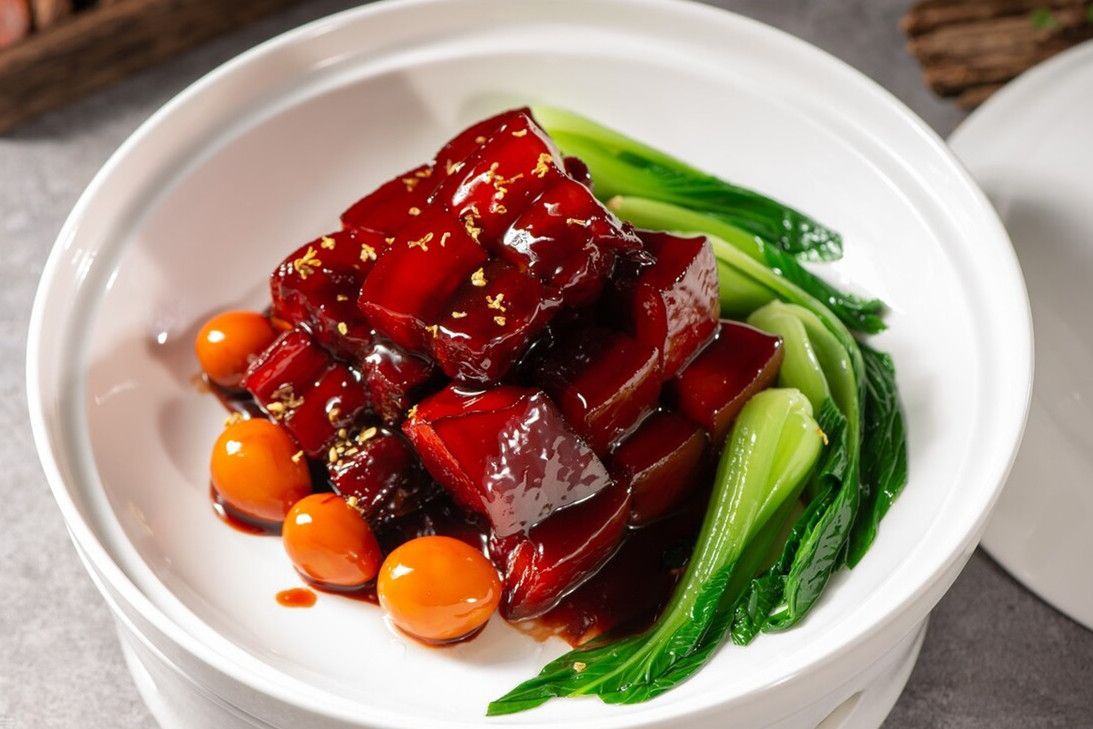✨ Introduction
In Shanghai, food is more than nourishment — it is the city’s language.
From rich and savory benbang dishes to delicate xiaolongbao, from sizzling shengjian on the street to elegant fusion cuisine, every flavor tells a story of openness and creativity.
As China’s first city to embrace Western dining, Shanghai preserves the essence of Jiangnan cuisine while blending global influences.
Join us on a journey of taste — through history, tradition, and innovation.
🏮 1. Birth of Local Cuisine — Essence of Jiangnan
Shanghai’s benbang cai (local cuisine) emerged in the late 19th and early 20th centuries.
It evolved from Jiangnan cuisine, combining regional techniques and local tastes into the famous “rich oil and red sauce” style.
Key Features
- Rich Oil, Red Sauce: Glossy, flavorful, slightly sweet.
- Precision in Heat: Mastery of timing and temperature.
- Fresh Ingredients: Natural taste comes first.
- Balanced Flavors: Sweet and savory in harmony.
Representative Dishes
- Hongshao Rou — Red-braised pork, tender and glossy.
- Baiqie Ji — White-cut chicken, light and fresh.
- Tangcu Paigu — Sweet and sour ribs, popular with all ages.
- Youbao Xia — Fried shrimp, crisp and fragrant.
🥟 2. Street Delights — Shanghai’s Everyday Flavors
Small bites, big memories.
Shanghai’s snacks reflect the city’s warmth, rhythm, and love for flavor.
Shengjian Bao (Pan-Fried Buns)
Crispy on the bottom, soft on top, juicy inside — a classic Shanghai breakfast.
Xiaolongbao (Soup Dumplings)
Thin skin, rich filling, hot broth. Bite, sip, and enjoy — the world’s favorite Shanghai symbol.
Xieke Huang (Crab Shell Pastry)
Golden, flaky pastry filled with sweet or savory fillings — a taste of old Shanghai.
Cifan Tuan (Glutinous Rice Roll)
Sticky rice wrapped around fried dough and pickles — simple, hearty, unforgettable.
🍽️ 3. Western Cuisine — The First Taste of the West in China
Shanghai was China’s first gateway to Western dining.
From the 1850s onward, Western restaurants appeared across the concessions, leaving a lasting influence.
Development Path
- Port Opening: Western food introduced by foreign merchants.
- Concession Era: Restaurants flourished along the Bund.
- Republican Period: Western dishes adapted to local tastes.
- Modern Times: “Hai Pai” (Shanghai-style) Western cuisine thrives.
Flavors from Afar
- French: Elegant and refined.
- Italian: Fresh and natural.
- German: Hearty and strong.
- Russian: Rich and comforting.
Localization
Blending Chinese ingredients, adjusting tastes, and combining East-West techniques — Shanghai created its own “Western cuisine with Chinese flavor.”
🌏 4. Fusion and Global Dining — A World on the Table
Modern Shanghai welcomes cuisines from every corner of the world.
Chefs reinterpret global classics, creating new culinary dialogues.
Japanese Cuisine: From sushi to ramen, izakaya culture thrives.
Korean Cuisine: Barbecue, kimchi, and hotpot are everyday favorites.
Southeast Asian Cuisine: Thai, Vietnamese, and Singaporean dishes add tropical flair.
European & American Cuisine: From burgers to afternoon tea, the city offers a full international menu.
🏙️ 5. Culinary Districts — Taste the City
City God Temple
Traditional snacks and century-old brands — a taste of old Shanghai.
Xintiandi
International restaurants and stylish nightlife — where East meets West.
Tianzifang
Creative cuisine in a maze of artsy alleys.
The Bund
Fine dining with a river view — elegance and heritage combined.
🍵 6. Food Experience Guide
Recommended Restaurants
- Local Cuisine: Lao Zhengxing, Dexing Guan, Lao Fandian
- Xiaolongbao: Nanxiang Xiaolong, Din Tai Fung, Jiajia Tangbao
- Shengjian: Dahuchun, Fengyu Shengjian, Xiaoyang Shengjian
- Western Dining: Bund 18, Peace Hotel, Waldorf Astoria
Dining Hours
- Breakfast: 7:00–9:00 – try shengjian or xiaolongbao
- Lunch: 11:30–13:30 – traditional local dishes
- Afternoon Tea: 14:00–16:00 – Western cafés
- Dinner: 18:00–20:00 – fusion or fine dining
Price Range
- Street Snacks: ¥5–20
- Casual Dining: ¥50–150 / person
- Mid-range: ¥150–300 / person
- Fine Dining: ¥300–800 / person
Dining Etiquette
- Local Cuisine: Shared dishes for families.
- Western Cuisine: Formal, suitable for business.
- Japanese Cuisine: Quiet and refined.
- Fusion Dining: Relaxed, ideal for social or romantic occasions.
🗺️ 7. Food Map of Shanghai
| Type | Area | Highlights |
|---|---|---|
| Traditional Food | City God Temple, Yu Garden, Nanjing Road | Old flavors, time-honored brands |
| Global Cuisine | Xintiandi, The Bund, Lujiazui | Modern international dining |
| Creative Dining | Tianzifang, M50, 1933 Old Millfun | Artistic, innovative restaurants |
| Night Markets | Wujiang Road, Changli Road, Shouning Road | Local snacks, late-night energy |
🌟 Conclusion
In Shanghai, every meal tells a story.
Behind each dish lies a century of encounters — between East and West, past and present.
Taste the city, and you taste its history, creativity, and spirit.
